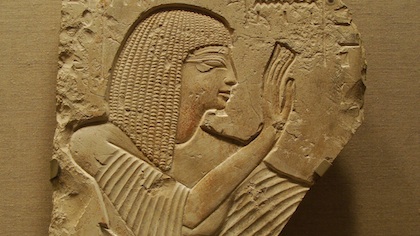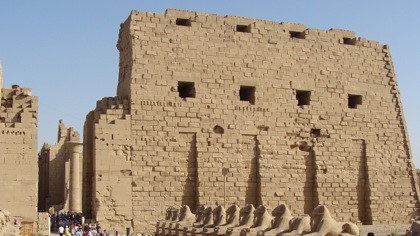 Continue reading “41: Egyptian Art Doesn’t Change over Time”
Continue reading “41: Egyptian Art Doesn’t Change over Time”
29: Karnak
 Welcome back to the Ancient Art Podcast, your guidebook to the art and culture of the ancient Mediterranean world and beyond. I’m your friendly traveling companion, Lucas Livingston.
Welcome back to the Ancient Art Podcast, your guidebook to the art and culture of the ancient Mediterranean world and beyond. I’m your friendly traveling companion, Lucas Livingston.
A few weeks ago, I had the fantastic opportunity to travel to Egypt and Jordan as a study leader through the Art Institute of Chicago. It was a great trip and I met some wonderful people. A big shout out to our intrepid travel director K.C. for her tireless effort. And even though most of the destinations we visited during the trip were thousands of years old, it sure seemed like a lot had changed since the last time I had been to the pyramids of Giza, Karnak and Luxor temples, the Valley of the Kings, and the mortuary temple of Pharaoh Hatshepsut at Deir el Bahri. A lot has also changed technologically since the last time I was there back in 1997; in particular with 35 mm film giving way to digital photography, encouraging wanton abuse of photographic hysteria. If you’re not already a fan of the Ancient Art Podcast on Facebook at facebook.ancientartpodcast.org or if you don’t follow me on Twitter at LucasLivingston, you might not yet have seen the hundreds of photos I uploaded from the trip. Well, head on over to either or and check them out.
Or to keep it really simple, go to ancientartpodcast.org and click on “Resources” to see links to the photo gallery and an interactive Google map with the geotagged photos. As an extra bonus there’s also a link to interact with the photos in Google Earth. So check it out.
My visit to Egypt and Jordan provided me not only with plentiful imagery, but also with copious fodder for the podcast. I thought a good launch pad would be an introduction to the amazing Karnak temple from Ancient Egypt. There’s so much to explore at Karnak that we’ll probably need a couple episodes here. This episode will give us an orientation in and around the temple. We’ll explore its grounds and layout, some of the architecture and history, and the different divinities revered at the sacred site. In the next episode, number 30, we’ll look a bit more closely at some of the decoration, the spiritual and political function of the temple, and the overarching philosophy and symbolism of Ancient Egyptian temple architecture in general.
Karnak is located in Upper Egypt, which means southern Egypt, because it goes by elevation, not latitude. Karnak, Luxor, the Valley of the Kings, and so many of Egypt’s other famous monuments are all clustered together in an area where the Nile makes a sharp bend around a relatively mountainous region. This is location of the ancient city of Thebes, given that name by the Greeks after the Greek city of the same name. The Ancient Egyptian name for Thebes was Waset. The name “Karnak” comes from the nearby modern village of the same name, as does the name of the nearby temple Luxor (al-Uqsur, meaning “The Palaces”). To the Ancient Egyptians, though, Karnak was known as Ipet isut, meaning “The Most Select of Places.” [1]
Karnak was more or less under continuous construction from the Middle Kingdom through the Roman era—that’s like 2000 years! The most ancient sections of Karnak in the deepest recesses of the sanctuary date back as far as Senusert I of the 12th dynasty, who ruled from 1971-1926 BC. The greatest period of construction and expansion was during the New Kingdom, around 1550-1307 BC. Nearly all the New Kingdom pharaohs left their mark on Karnak in some way or another.
Karnak is comprised of three main temple precincts dedicated to different gods. The largest precinct in the center is dedicated to Amun, or more properly Amun-Ra, after the two gods became syncretized. Within that precinct are many shrines, chapels, and subsidiary temples dedicated to different gods and pharaohs, including of course the Great Temple of Amun. To the north is the precinct of Montu, the falcon-headed Theban god of war. Montu was especially popular during the Middle Kingdom, which we see reflected in the names of the 11th dynasty kings Mentuhotep I, II, and III. Mentuhotep II, who ruled from 2061-2010, is the fellow who built his mortuary temple nestled in the foothills of the western mountains at Deir el Bahri, where Hatshepsut later build her famous mortuary temple modeled heavily after Mentuhotep’s, but we’ll save all of that for another episode of the podcast. South of the precinct of Amun connected by a long path or avenue lined by ram-headed sphinx statues lies the precinct of the goddess Mut, wife of Amun and the divine mother to the reigning pharaoh.
The avenue of sphinxes jogs around the temple of Mut and then continues roughly southward lined by human-headed sphinxes all the way to the Temple of Amun at Luxor. Over the years, the city of Luxor was built up on top of the avenue of sphinxes, but there’s a massive project underway today to excavate and reconstruct the avenue of sphinxes, reconnecting the ancient complexes and displacing lots of modern day residents. So you can imagine it’s been kind of controversial.
I’d be remiss if I didn’t mention the temple to the god Khonsu, which lies within the precinct of Amun. Khonsu or Khons is the son of Amun and Mut, so you have a nice family gathering here at Karnak, which makes a lot of sense, since temples were considered to be the mansions of the gods. So Karnak as a whole is a magnificent estate with different buildings, rooms, and wings dedicated to the divine family of Thebes. The Theban pantheon and theology has many layers of complexity on top of that, but that’s a simple perspective.
Flanking the southern side of the Amun temple at Karnak is a fantastically large open-air museum of architectural fragments covering about as much ground as the temple itself. The collection is comprised mostly of blocks that were discovered being used as filler inside the temple pylons. The pylons are those massive blocky gateways so characteristic of Egyptian architecture. Throughout the history of Karnak, not only do we see continuous expansion and construction, but we also have constant renovation and demolition to make way for what were in their day new construction projects. If an earlier king’s addition to Karnak got in the way of a later king’s plans, it was not uncommon to demolish the earlier section, and it was certainly a cost saving measure to reuse that stone, which had already been nicely quarried and shaped, which today would help you earn credits toward LEED certification.
The temple of Amun is constructed along two primary axes; one running perpendicular to the Nile and the other running parallel. The perpendicular axis is generally designated east-west and the other north-south, but the temple is not actually orientated precisely along the cardinal axes. In general, however, it was common for Egyptian temples to be orientated east-west. Many of the western Theban temples on the opposite side of the Nile face east towards the rising sun and the river, while Karnak faces west, again towards the river for one for the very practical purpose of accessibility by boat. The first pylon is about 540 meters from the Nile today (in American units, that’s about 6 football fields), but in its day there was quay or a water way connecting it with the river. All in all, the temple of Amun is comprised of 10 pylons dating from the 18th dynasty through the 30th dynasty. While construction jumped around from place to place within the temple, the pylons generally radiate outward chronologically. So the first pylon where all tourists today enter is the latest from the 30th dynasty, the second pylon is older (late 18th-early 19th dynasty), and so on.
Between the first and second pylons is an open-air courtyard. What’s neat here is that this space was outside the temple proper in the New Kingdom, so you can see some sphinx statues here that were originally part of the avenue of sphinxes connecting to the Nile. You’ll also find some unfinished columns and the massive mud-brick scaffolding that was never removed after construction of the first pylon was halted. I think it’s really interesting to see evidence like this revealing the history and development of Karnak. It breathes a little life into the ancient stone, betraying that there was frequent expansion and renovation. It’s easy to visit Karnak today and take it for granted that we’re looking at a frozen snapshot in time, but that’s not the case. As we walk through this ancient complex, we’re treading across more than 100 generations of continuous occupation, development, devotion, and human achievement.
So, there’s a tight little introduction to Karnak and Ancient Egyptian temples. I hope you’ll tune in to the next episode, where we’ll go deeper into the temple, exploring the carvings on the walls, their meaning and symbolism. We’ll recreate an Ancient Egyptian festival and then we’ll learn how the temple as a whole functions as a symbol of Ancient Egyptian mythology and spiritual beliefs.
If you enjoy the podcast and want to help support it, please consider leaving your comments on iTunes and YouTube. You can also give your feedback at ancientartpodcast.org. Just click on the Feedback link at the top of the page. And I appreciate your comments, suggestions, and questions at info@ancientartpodcast.org. Thanks for listening and see you next time on the Ancient Art Podcast.
©2010 Lucas Livingston, ancientartpodcast.org
———————————————————
Footnotes:
[1] Wilkinson, Richard H. The Complete Temples of Ancient Egypt. New York: Thames & Hudson, 2000, p154.
